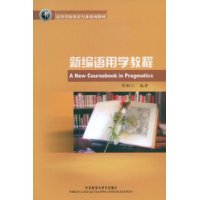新编语用学教程(高等学校英语专业系列教材)
标 签:教材与辅导 大学 教材教辅与参考书 教材 大学英语 英语与其他外语
“高等学校英语专业系列教材”是一套为英语专业高年级本科生和研究生编写的教材,包括高级英语语言技能、英语专业知识和相关专业知识三个方面。本系列教材为开放式,涵盖面广,设计科学,注重时代性、知识性与实用性,有助于学习者在掌握英语技能的蕞础上进一步扩充知识领域,培养应用能力。提高综合素养。
Introduction
0.1 Introducingthefieldofpragrnaties
0.2 Theemergenceofpragrnatiesasafield
0.3 Pragmaticsasabranchoflinguistics
0.4 Pragrnaticsasafunctionalperspective
0.5 Basicnotionsinpragmaticstudies
In-ClassActivities
Exercises
RecommendedReadings
PartⅠ FromPhilosophyofLanguagetoLinguisticPragmatics
Unit1 Austin'sSpeechActTheory
Pre-RlassReading
1.1 Wordsanddeeds
1.2 Propertiesofanexplicitperformativeutterance
1.3 Locution,illocution,andperlocution
1.4 (Illoeutionary)Speechactsclassified
In-ClassActivities
Exercises
RecommendedReadings
Unit2 SAT:LaterDevelopments
Pre-RlassReading
2.1 (Illocutionary)Speechactsreclassified
2.2 Felicityconditions
2.3 Indirectspeechacts
2.4 Extendedspeechacts
In-ClassActivities
Exercises
RecommendedReadings
Unit3 GriceanPragmatics:lmplicature
Pre-RlassReading
3.l Naturalvs.non-naturalmeaning
3.2 Implicaturdandimplication
3.3 Typesofimplicatures
3.4 Featuresofconversationalimplicaturcs
In-ClassActivities
Exercises
RecommendedReadings
Unit4 GriceanPragmatics:TheCooperative
Principle
Pre-RlassReading
4.1 CP:theprinciple
4.2 CP:themaxims
4.3 Non-observanceofthemaxims
4.4 Calculatingconversationalimplicatures
In-ClassActivities
Exercises
RecommendedReadings
Unit5 Neo-GriceanPragmatics
Pre-ClassReading
5.1 Q-andR-Principles
5.2 Q-,I-andM-Principles
5.3 Anaphora:acasestudy
In-ClassActivities
Exercises
RecommendedReadings
PartⅡ AspectsofLinguisticInteractior
Unit6 Deixis
Pre-ClassReading
6.1 Theencodingofcontext
6.2 Deixis:typesandproperties
6.3 Persondeixis
6.3 Placedeixisandtimedeixis
6.5 Socialdeixisanddiscoursedeixis
In-ClassActivities
Exercises
RecommendedReadings
Unit7 PragmaticPreSuppoSition
Pre-ClassReading
7.1 Entailmentandpresupposition
7.2 Pragmaticpresupposition
7.3 Cancellationofpresupposition
7.4 Projectionproblemswithpresupposition
7.5 Presuppositiontriggers
In-ClassActivities
Exercises
RecommendedReadings
Unit8 ConversationAnalysis.
Pre-ClassReading
8.1 Tum-takinginconversation
8.2 Adjacencypairs.
8.3 Presequences
8.4 Conversmionalrepairs
ln-ClassActivities
Exercises
RecommendedReadings
Unit9 PolitenessinConverSation
Pre-ClassReading
9.1 Approachestopoliteness
9.2 PP:theprincipleanditsmaxims
9.3 Clashesandtradeoffsbetweenthemaxims
9.4 PP:areformulation
In-ClassActivities
Exercises
RecommendedReadings
Unit10 DoingFTAsinConversation
Pre-ClassReading
10.1 Thenotionofface
10.2 Face-threateningacts
l0.3 StrategiesofdoingFTAs
10.4 Factorsbehindthestrategychoice
In-ClassActivities
Exercises
RecommendedReadings
PartⅢ ConstructingUnifiedTheoriesof
LanguageUse
Unit11RelevanceTheory(1)
Pre-ClassReading
11.1 Communication:thecodemodel
11.2 Communication:theinferentialmodel
11.3 Communication:ostensionandinference
11.4 ContextinRT:acognitiveconstruct
11.5 Relevance:cognitiveeffectsand
processingefforts
In-ClassActivities
Exercises
RecommendedReadings
Unit12RelevanceTheory(2)
Unit:13AdaptationTheory
PartⅣ Pragmatics:TwoApplications
Unit14PragmaticsandTranslation
Unit15DevelopingL2PragmaticCompetence
Glossary
DataTranscriptionNotations
References
Leech'S Politeness Principle,although widely acclaimed,hasreceived some criticisms.Among others.his use of the term“maxim”iSquestioned for its moral and imperative connotations.Thus,Leech(2005)decides to reformulate the six maxims into something that sounds morelike pragmatic constraints.One single super-constraint he invents is theGrand Strategy of Politeness(GSP for short):In order to be polite,S expresses or implies meanings whichplace a high value on what peRains to 0(0=other person[s],[mainly the addressee]or place a low value on what pertains toS(S=self,speaker).(Leech,2005)Politeness in a pragmatic sense is a matter of conveying meanings inaccordance with the GSE Politeness often shows up in opposite strategiesof treating S and H in dialogue.Whereas conveying a highly favorableevaluation of H is polite,conveying the same evaluation of S is impolite.While conveying an unfavorable evaluation of S is polite,.giving thesame evaluation of H iS impolite.Under the super-constraint,Leechidentifies a set of sub—constraints which have variable constraining power:
A.Place a high value on H'S wants;place a low value on S's wants;
B.Place a high value on H'S qualities;place a low value on S'squalities;
C.Place a high value on S's obligation to H;place a low value on H'Sobligation to S:
D.Place a high value on H'S opinions;place a low value on S'sopinions;
E.Place a high value on H'S feelings;place a low value on S'sfeelings.
These constraints above are simply the most importantmanifestations of the GSP and there may be others.Moreover,the
constraints towards the end of the list are less powerful than those at thetop.Politeness can be measured in terms of two scales:one beingabsolute politeness scale and the other being relative politeness scale.
装 帧:平装
页 数:230
版 次:1版
开 本:16开
正文语种:中文/英语
